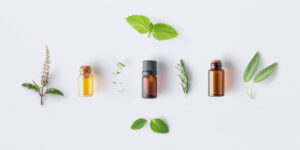How do I choose the best application for essential oils?
Choosing the appropriate exposure method is one of the first steps in developing or purchasing a botanical remedy. Understanding the exposure method is also one of the anchors in dose development and toxicology. There are three main methods that nearly any product will fall under:
- Inhalation: essential oils, aromatic herbs
- Topical: essential oils, whole herbs, herbal preparations
- Ingestion: essential oils, whole herbs, herbal preparations
Guidelines for applications and safety differ depending on exposure method and purpose. This information will focus on topical and ingested preparations and the array of products that fall in these categories.
HOW CAN I USE BOTANICAL REMEDIES TOPICALLY?
Topical applications vary depending upon the ultimate purpose of the application. This includes skincare/spa product development, cosmeceuticals, and medicinal applications.
Personal Care Products
Skin care or spa products include lotions, creams, serums, and both personal care and luxury products. These are used for beautification and sanitation purposes on a regular basis in liberal amounts. Recall from the toxicology lesson that most generalized dosing guidelines are formulated for this purpose. Additionally, because the aroma or emotional response are typically priorities in these products, they are often confused with traditional aromatherapy.
- Includes: lotions, creams, perfumes, cleansers, and other routine-use products
- Function: Self-care, beautification, relaxation
- Duration: Long term, daily use, suitable for indefinite exposures for all ages and health status
- Safety: Focuses on unlimited, unrestricted uses and applications. Because usage is unrestricted by both time and exposure, total concentration of active product is often below the therapeutic dose.
Cosmeceuticals
Cosmeceuticals are cosmetics that also have medicinal actions, such as anti-aging products or scar treatments. While still aroma-driven, dosing will be stronger. They are neither medications nor personal care products, so they can be classified either way, depending upon the claims.
- Includes: Lotions, creams, serums, and ointments designed to treat a specific cosmetic condition
- Function: Beautification through treatment of specific skin-related conditions
- Duration: Long term, limited applications
- Safety: To achieve efficacy, these products often extend beyond skin care limitations but extreme limitations still must be in place due to indefinite use
Medicinal Topical Preparations
Medicinal topical products include healing balms, antiseptic ointments, and similar applications. Because they require concentrations large enough to reach therapeutic dose, these products are used on an as needed basis in short term and precise applications.
- Includes: Balms, Salves, Poultices, Ointments
- Function: Curative benefits
- Duration: Short-term, as needed to treat specific conditions
- Safety: Because larger concentrations are used, dosing is not interchangeable with personal care product restrictions. Limits may be required for total duration, application size, and age or weight.
HOW SHOULD I INGEST BOTANICAL REMEDIES?
Ingestion is often considered at the top of some hierarchy of application options, especially where essential oils are considered. However, the fact is that it’s neither inherently stronger nor more risky. Ingestion applications cover a wide range of options.
Culinary Preparations
Because herbalism is a field in which food-based products are used in stronger doses as medicine, applications vary depending upon whether the goal is lifestyle or treatment-based. The focus can be either on either flavor or health promotion, and the driving principle typically aligns with “let your food be your medicine.” Culinary applications include routine recipes and family favorites which are produced with the goal of routine nourishment and flavor.
- Includes: Pestos, popsicles, salads, sauces, teas, syrups, vinegars, honeys, etc.
- Function: Flavoring agents for meals and treats
- Duration: Long term, daily use, suitable for indefinite exposures for all ages and health status
- Safety: Focuses on unlimited, unrestricted uses and applications. Because usage is unrestricted by both time and exposure, total concentration of active product is often below the therapeutic dose.
Supplementation
Still driven by food as medicine, supplementation leans a bit more heavily on the “medicine” side. Usually in the form of capsules, syrups, tinctures, or teas, supplementation is used to prevent illness – especially when risks are increased – address deficiencies, promote overall system-related health, and attempt to cure chronic conditions.
- Includes: Nutrient based products such as tonics and vitamins or lower doses of medicinal products
- Function: Prevention/long-term treatment
- Duration: Long term, daily use, suitable for indefinite exposures
- Safety: Focuses on unlimited, unrestricted uses and applications with doses large enough to achieve efficacy
Medicinal Products
Medicinal products such as tinctures, syrups, capsules, teas, lozenges, and chewables are used as needed to address a specific health concern. These products are potent, stronger concentrations and may contain herbs, essential oils, or both.
- Includes: Tinctures, syrups, teas, glycerites, etc
- Function: Treat a specific condition
- Duration: Short term and as needed for a condition
- Safety: Stronger concentrations are used, so ingestion limits are not interchangeable with culinary products. Limitations may be required for duration, age or weight, and application frequency
WHY IS THE EXPOSURE METHOD IMPORTANT?
The exposure method and type determine both safety and efficacy of botanical remedy use. Using this information is the first step in the decision making process for dosing decisions. Of the major exposure methods, skin care products and culinary ingestion use herbs and oils at sub-therapeutic doses. They provide beautification and flavor but do not exist in sufficient quantities to achieve medical actions. Medicinal uses are always stronger and used for acute, temporary conditions.

